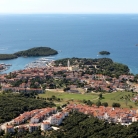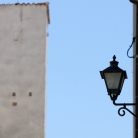The Main Town Gate
Next to the church of St. Fosca there is the eastern, that is the main gate. In the past centuries this was the main entrance to the fortified town, which as late as in the 19th century began to expand down the hill slopes. (Until the 19th century there were only a few lonely houses or some church outside the walls).
This Romanesque gate dates from 13th century. A semicircular arch is carefully carved. Once the gate was provided with iron-bound wooden wings made of hard Istrian oak. At the inner part of the gate-posts two rings still can be seen - one made of stone and the other of iron, by means of which the wooden wings were fixed to the posts. The gate was part of town walls, so aove ai a fragment of the ancient wall has been preserved. On a stone tile formed like a shield there is shallow relief with a floral motif representing a miniature lion of St. Mark (symbol of the Venetian Republic) holding a Mark the Evangelist's book.
The lion has raised wings and lowered tail and in his paws he holds a closed book, what means the relief was made during the war time. The peacetime lions used to have an open book in their paws with the Latin text: PAX TIBI MARCE EVANGELISTA MEUS (Peace to you, my Mark the Evangelist). The lion resembles the Venetian lions from the 14th century, but also the ones from the 15th and 16th century, therefore it is very defficult to date it precisely. The first Venetian lions appeared on public buildings in Istria at the end of the 13th and beginning of the 14th century. (From the 10th till the 18th century Vrsar belonged to the Poreč bishopric, so maybe the lion had been brought here from somewere else and put above the gate after 1778, when Venice took Vrsar over from the Poreč Bishops).In front of the gate, on the left side, there is the fitst school building dating from the 19th century.














